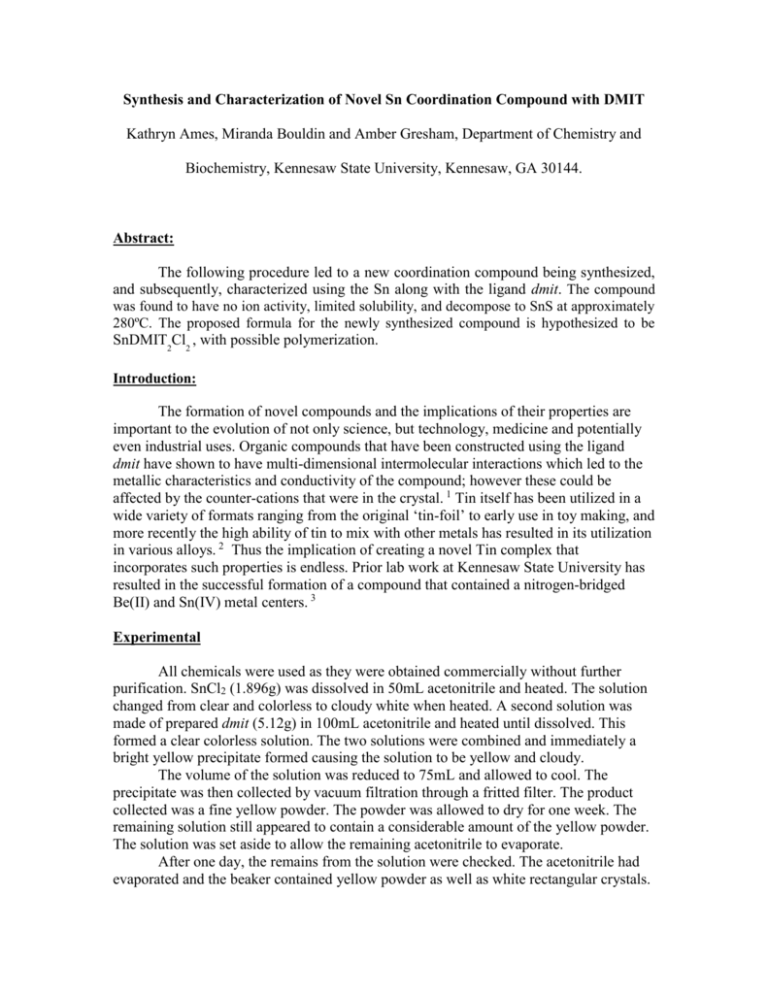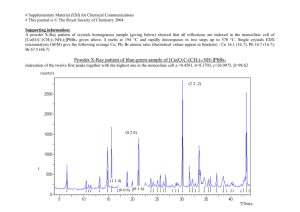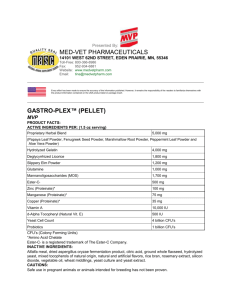The Preparation of Metals and Metal Oxides
advertisement

Synthesis and Characterization of Novel Sn Coordination Compound with DMIT Kathryn Ames, Miranda Bouldin and Amber Gresham, Department of Chemistry and Biochemistry, Kennesaw State University, Kennesaw, GA 30144. Abstract: The following procedure led to a new coordination compound being synthesized, and subsequently, characterized using the Sn along with the ligand dmit. The compound was found to have no ion activity, limited solubility, and decompose to SnS at approximately 280ºC. The proposed formula for the newly synthesized compound is hypothesized to be SnDMIT2Cl2 , with possible polymerization. Introduction: The formation of novel compounds and the implications of their properties are important to the evolution of not only science, but technology, medicine and potentially even industrial uses. Organic compounds that have been constructed using the ligand dmit have shown to have multi-dimensional intermolecular interactions which led to the metallic characteristics and conductivity of the compound; however these could be affected by the counter-cations that were in the crystal. 1 Tin itself has been utilized in a wide variety of formats ranging from the original ‘tin-foil’ to early use in toy making, and more recently the high ability of tin to mix with other metals has resulted in its utilization in various alloys. 2 Thus the implication of creating a novel Tin complex that incorporates such properties is endless. Prior lab work at Kennesaw State University has resulted in the successful formation of a compound that contained a nitrogen-bridged Be(II) and Sn(IV) metal centers. 3 Experimental All chemicals were used as they were obtained commercially without further purification. SnCl2 (1.896g) was dissolved in 50mL acetonitrile and heated. The solution changed from clear and colorless to cloudy white when heated. A second solution was made of prepared dmit (5.12g) in 100mL acetonitrile and heated until dissolved. This formed a clear colorless solution. The two solutions were combined and immediately a bright yellow precipitate formed causing the solution to be yellow and cloudy. The volume of the solution was reduced to 75mL and allowed to cool. The precipitate was then collected by vacuum filtration through a fritted filter. The product collected was a fine yellow powder. The powder was allowed to dry for one week. The remaining solution still appeared to contain a considerable amount of the yellow powder. The solution was set aside to allow the remaining acetonitrile to evaporate. After one day, the remains from the solution were checked. The acetonitrile had evaporated and the beaker contained yellow powder as well as white rectangular crystals. The crystals and the powder were analyzed by the Spectrum One FT-IR Spectrometer. The melting point range for both compounds was also tested using the Mel-Temp. The yellow powder was tested for solubility in several solutions: methanol, ethanol, hexane, chloroform, water, and ethyl acetate. The crystal-powder mixture was grounded with a mortar and pestle and combined with 50mL chloroform to dissolve the excess dmit—this was the original rectangular crystals. The solution was once again vacuum filtered using a fritted filter. This time, all of the powder appeared to be collected and a clear yellow solution remained. The powder was allowed to dry. The dry powder was again checked for melting point range on the Fisher-Johns Melting Point Apparatus. A second IR spectrum was taken using the Spectrum One FT-IR Spectrometer. The yellow powder (16mg) was also tested using the Shimadzu Thermogravimetric Analyzer TGA-50. A stock solution was prepared by dissolving 0.1999g of the yellow tin complex with 10mL concentrated nitric acid in a 100mL volumetric flask. A yellow mixture resulted as well as the evolution of brown gas. The mixture was then diluted with deionized water to a total volume of 100mL. A test for halides was performed on 10mL if the stock solution. Several drops of AgNO3 were added to the solution and a white precipitate was formed. A 100 ppm sample of the complex was prepared by adding 5mL stock solution to a 100mL volumetric flask and diluting to 100mL with deionized water. The 100 ppm sample was then tested for the percentage of tin using the SpectrAA 220 Atomic Absorption Spectrometer. To test the conductivity of the complex, a 10-3 M solution was prepared with 0.1765g of the yellow powder with 50mL acetonitrile. The solution was then tested for conductivity using the YSI 31 Conductivity Bridge. Results and Discussion Table 1. Other Data Collected for the Color, Melting Temperature, Atomic Flame Absorption, Halide Test, Conductivity, and Final Mass Test Color Mass (g) Percent Yield (%) Percentage of Sn in 100 ppm Solution (%) Halide Test Melting Temperature Conductivity Tin Complex Yellow 2.7212 61 32.24 Positive N/A N/A Table 2. FT-IR Data and Assignments 4 IR Reading (cm-1) 3123 1526 1491 675 Peak 1 Peak 2 Peak 3 Peak 4 Assignment Alkene (C-H) Alkene (C=C) Alkane (C-H) Halide (Cl) Table 3. Solubility of SnDMIT2Cl2 Solution Methanol Ethanol Hexane Chloroform Water Ethyl Acetate Result Partially soluble when heated Partially soluble when heated Partially soluble when heated Insoluble Insoluble Insoluble Figure 1. TGA Results for SnDMIT2Cl2 T G A of T in (II) D MIT C hloride 0 0 100 200 300 Change in Sample Mass (mg) -2 -4 -6 -8 -10 -12 T im e (s) 400 500 600 The tin complex that was synthesized through this experiment was placed through a series of test to determine specific properties and its possible structure; data collected from these test can be seen in Tables 1, 2, and 3. The tin complex was a bright yellow color on formation when the acetonitrile solutions of DMIT and SnCl2 were added together. This powder was the tin complex that was analyzed however, as was mentioned above, a white crystal was also found. The crystal was disregarded after an FTIR scan and the melting temperature was taken. The crystal had a melting temperature of 185-193C which was almost exactly the same melting temperature of DMIT. The FTIR gave the exact peaks as DMIT crystals which showed that the crystals were nothing more than excess DMIT. Enough DMIT was added to the original solution to allow four DMITs to react with the tin (II) chloride to form an octahedral complex with six ligands, however since there was a significant amount of left over DMIT, the complex was very unlikely an octahedral. This gave a hint that the possible structure of the tin complex was tetrahedral or square planar with only four ligands. At this point, the powder was isolated by rinsing the crystals and powder with chloroform and then filtering the solution leaving only the powder. Atomic mass absorption was also used to determine possible structures. The Atomic mass absorption gave a percentage of tin to be about 32 percent per 100 parts. This suggest that the structure of the complex to be SnDmit2Cl2 which would have a total mass of 445.7 grams where tin makes up about 30 percent of the mass. This would have a tetrahedral or square planar structure as expected from the excess DMIT data. A melting temperature was taken for the yellow powder but the powder showed no signs of melting by 300ºC. The powder was then tested using a TGA-50 and the powder was found not to have a melting point at all, instead the powder starts decomposing at 280ºC and by 320ºC only 37 percent of the mass was left from the powder that was originally placed in the machine. Through a few calculations, it was found that the 63 percent of the original mass had evaporated, and the 37 percent of the original mass was probably SnS residue. The data collected from the TGA-50 can be seen in Figure 1. A halide test was taken to determine if the complex had halides present. A precipitant was formed during the test which determined that the complex did have a halide present. Also, the conductivity of the complex was taken to determine if any ions were bonded outside of the coordination sphere. However, the complex had no conductivity which meant that it did not ionize in solution. This suggests that the halides present in the complex are bonded to the tin inside of the coordination sphere instead of outside. An FT-IR spectrum was also read to determine if the ligands that were bonded to the tin were DMIT. Any bonds to the tin would not be read using the FT-IR but the DMIT and chlorine peaks would be visible. Several peaks were read on the IR scan, however on the peaks at 3123, 1526, 1491, and 675 cm-1 are really notable. The peaks at 3123, 1526 and 1491 cm-1 were the peaks used to determine the DMIT crystals. The peak at 3123 cm-1 was assigned to be a carbon-hydrogen bond of an alkene. The peak at 1526 cm-1 was assigned to be a carbon-carbon double bond of an alkene. The peak at 1491cm-1 was assigned to be a carbon-hydrogen bond of and alkane. These three peaks are the main peaks associated with DMIT. However the fourth peak at 675 cm-1 was assigned to a chlorine bond. This would be expected because the tin complex had chlorine bonded to it.4 Also the solubility of the complex was taken to determine solubility properties that could be used for further research. The complex was not soluble in chloroform, water, or ethyl acetate. However it was partially soluble in methanol, hexane, and ethanol with heating. Further research could include forming crystals and determining crystal structures. This was not completed during this experiment because time did not allow for this. However, knowing what the powder is slightly soluble in will help to form crystals later on. Also, further research could be done to explore the indications of this complex whether in the medical, industrial, or technological field. Conclusion From the data collected it was determined that the possible structure of the tin complex was a tetrahedral or square planar structure—meaning only 4 ligands present. However which structure is not determinable at this point without more research and with x-ray crystallography. The compound is probably SnCl2DMIT2 with the chlorines within the coordination sphere. There is a possibility that the structure also is polymerizing due to the fact that many other metals with the same properties of tin form polymers when bonded to DMIT. 5, 6 This would have to be determined with more research. Reference: 1) Synthesis, structure and electrical properties of charge transfer complex [MDA] [Pd(dmit)2]2. Chinese Science Bulletin; September 2008, Vol 43. No.17. p1494-1496.2p. 2) http://www.chemistryexplained.com/elements/T-Z/Tin.html 3) Eichler Jack F., Oliver Just and William S. Rees Jr. Inorganic Chemistry Communications. Vol, 8, Issue 10, October 2005, p.936-938.2p 4) Ault, A. Techniques and Experiments for Organic Chemistry, 6th Edition. University Science Books, 1998: pp 188-189 5) Williams, D. J., Vanderveer D., Lipscomb, L. A., Jones, R. L. Main group metal halide complexes with sterically hindered thioureas XII. Crystallographic studies of lead (II) and Cadmium (II) thiocyanate complex with 1,2-dimethyl-2(3H)imidazolethione. Inorg. Chim. Acta.1992, 192, 51-57. 6) Williams, D. J., Jones, R. L., Poor, P. H. Main Group Metal Halide Complexe with Sterically Hindered Thioureas. VIII. Complexes of Lead(II) Halides with 1,3-dimethyl-2(3H)-Imidazolethione. Inorg. Chim. Acta. 1988, 144, 237-240.








